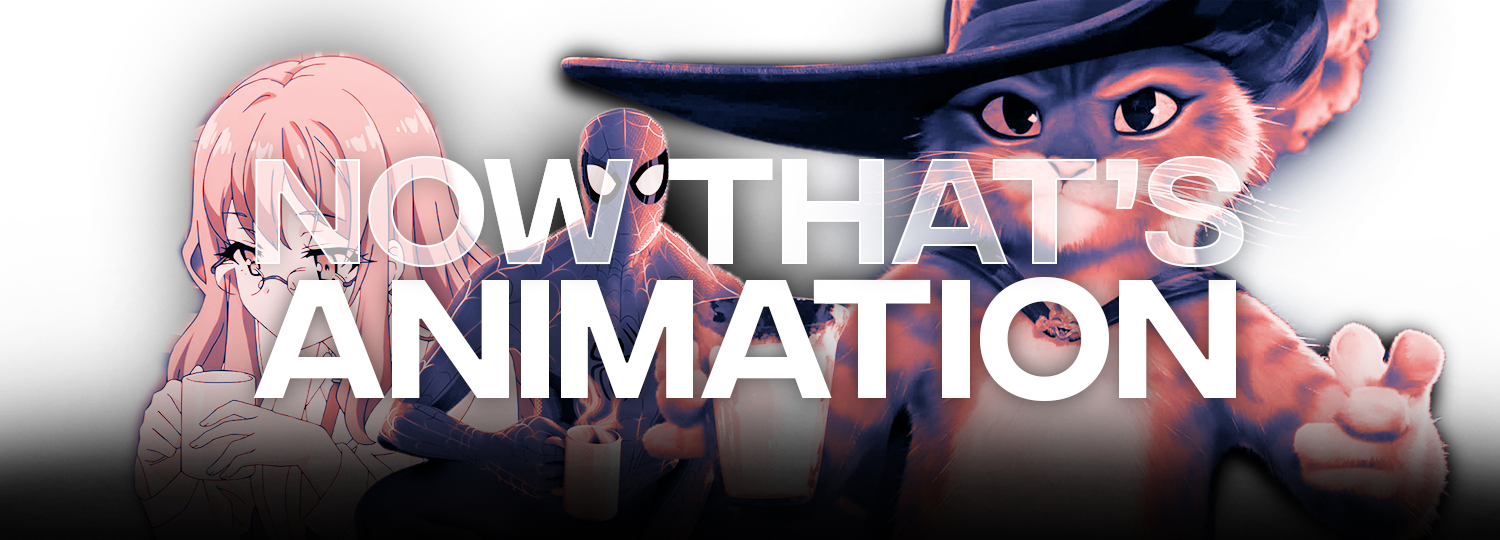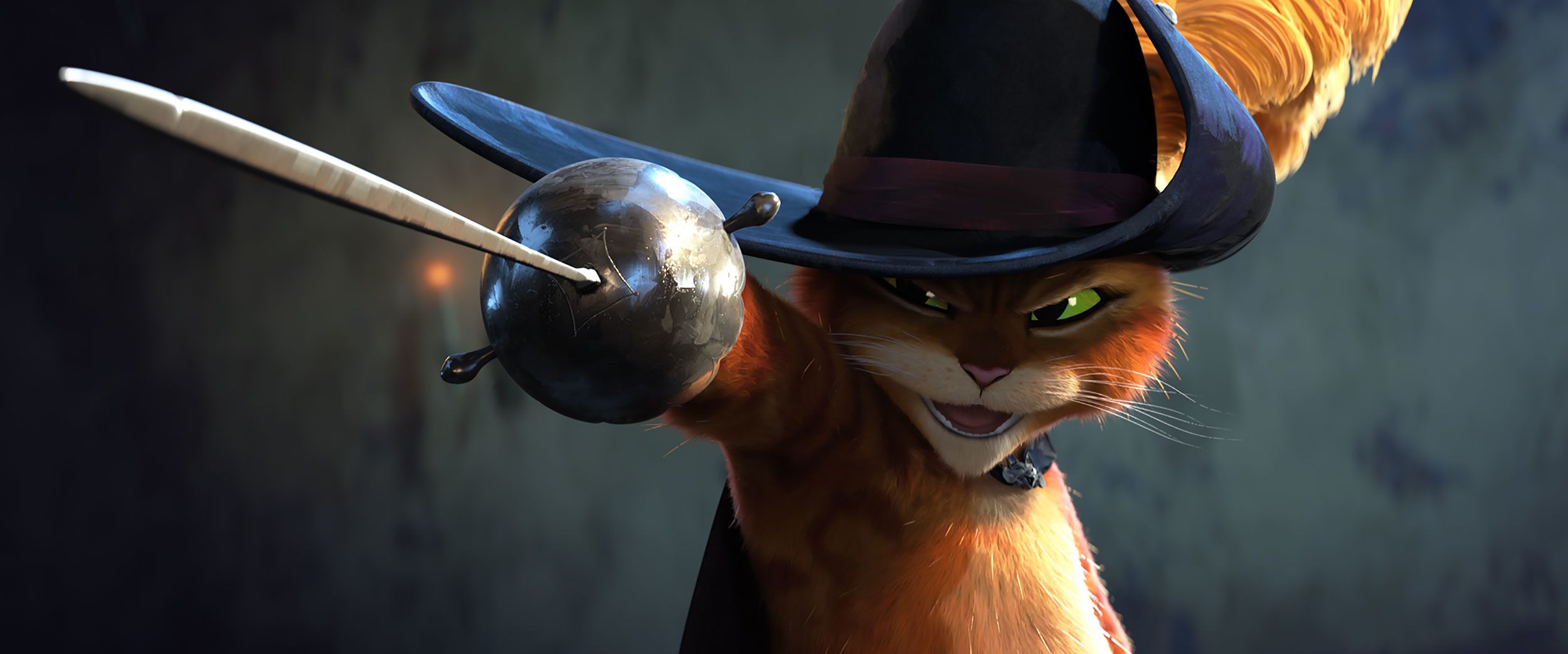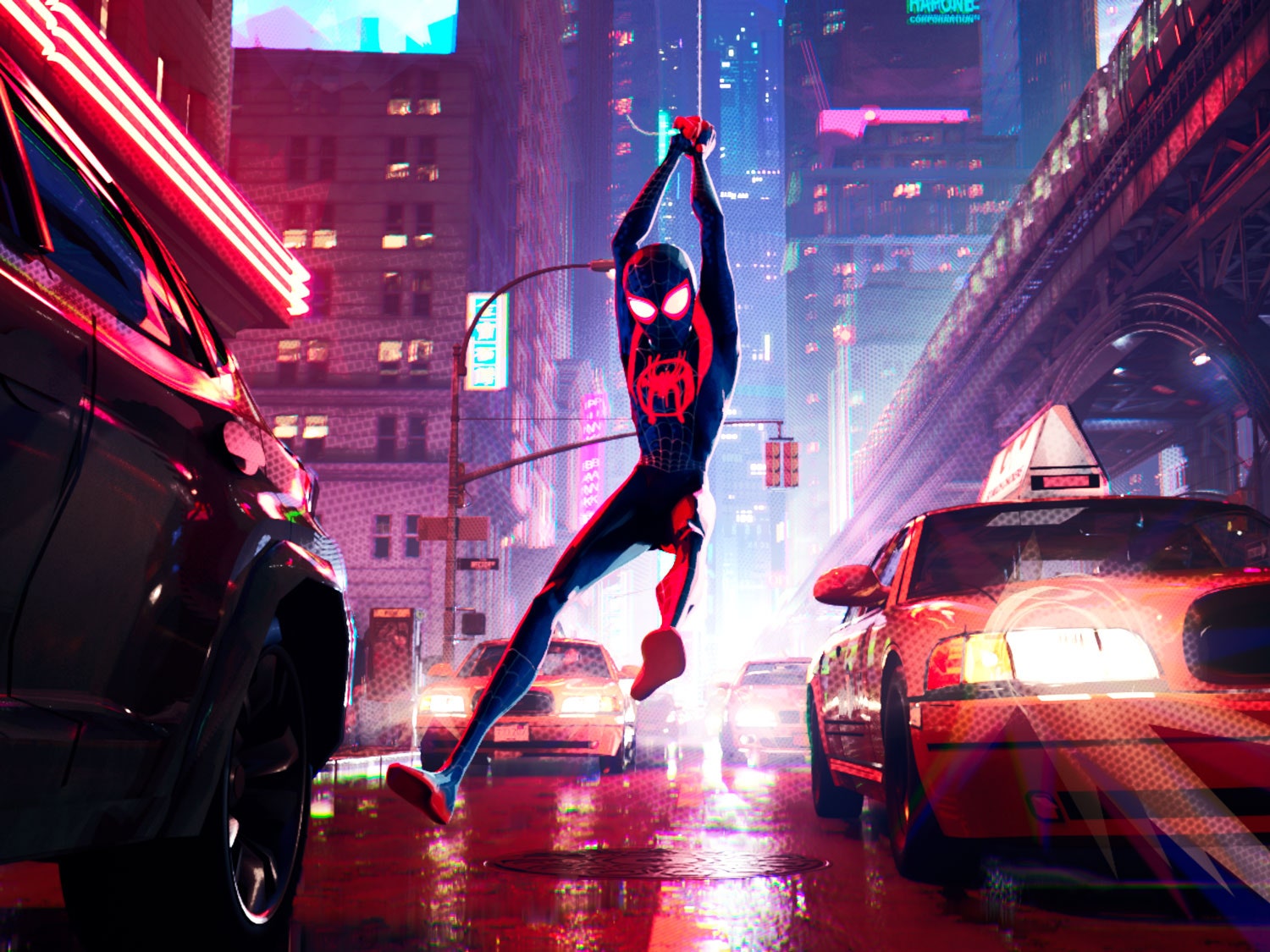
Everyone appreciates classic, cinematic live action films. Save the cartoons for the children! But as the decades passed, animated films have become so complex in both technique and story that even adults can enjoy them. Here are just 4 films that will make you wish Who Framed Roger Rabbit was real life!
Puss In Boots: The Last Wish
Matt P.I have absolutely no memory of what happened in 2011's Puss in Boots, nor the Netflix show The Adventures of Puss in Boots, but am happy to report a lack of Puss knowledge did not negatively impact my time watching an Antonio Banderas-voiced cat scurry around with his sword. When we pick up with Puss, he's a milk-drunk legend realizing he's wasted eight of his nine lives. Wolf, a physical manifestation of death who wields two scythes and is voiced by Narcos' Wagner Moura, could not be happier — all he wants is to cut down the arrogant feline as he begs for mercy. But when Puss catches wind of a fallen star capable of granting a wish, he sets off with Kitty Softpaws (Salma Hayek) and a tiny dog named Perrito (What We Do in the Shadows' Harvey Guillén) to seize the opportunity. On his fluffy tail are Goldilocks (Florence Pugh) and her Three Bears Crime Family, and the Shrek-verse's version of the Collector, “Big” Jack Horner (John Mulaney), who also want the star.

The Last Wish is the closest I've ever seen a movie get to emulating hand-painted concept art. On their way to the wishing star, Puss and company traverse prismatic backdrops — from bright pinks and green forests to the rustic interiors of a cat-lady prison — that feel dabbed on by the artistic team. Their encounters with beasties use color, linework, and kinetic camera moves to bring viewers deeper into the battles, and like The Way of Water, regularly shift frame rates to jolt the senses. Puss, looking more oil-painted than ever, may be monologuing about his legendary skills one second, animated “on the ones,” then find himself in a cacophonous skirmish with a towering troll the next, which the team animates “on the twos.” The sensation builds on the work of Spider-verse and drags the Shrek franchise, of all things, into the territory of high art. It's stunning.
Cast List
Antonio Banderas as Puss in Boots
Salma Hayek as Kitty Softpaws
Harvey Gullien as Perrito
Wagner Moura as Wolf
Florence Pugh as Goldilocks
The movie's also really funny? Having recently revisited Shrek 1 and Shrek 2, I can't say I walked into The Last Wish with an open heart/funny bone — pop culture hijinks and fairy-tale riffs were dusty then and petrified now. The Last Wish team, including credited screenwriters Paul Fisher and Tommy Swerdlow, reinvent the humor just like the animation. While the movie offers a few nostalgic nods to Shrek, with brief appearances by Gingerbread Man and Pinocchio, and Jack Horner's endless supply of fantasy literature collectibles gives Mulaney plenty of joke fuel, the movie's comedy stylings more closely resemble Groundhog Day. Banderas, it turns out, can do the Bill Murray mumbles-to-self one-liner thing. A recurring bit finds Puss reliving his past deaths, and the versions of himself (Showman Puss, Swole Puss, Drunk Puss) that led to each demise. In this sequel, a somewhat obligatory poop joke is actually a litter box joke about Puss faking his own death and “burying” his body. Good!
The Last Wish might just be the best thing DreamWorks Animation, a studio that isn't as known for pushing the limits of the medium, has produced in the last decade. 2010 gave us the emotional thrillride of How to Train Your Dragon and 2011 had Kung Fu Panda 2, a martial arts odyssey bursting with imagination that asserted director Jennifer Yuh Nelson as a top-tier action director (even if Hollywood never made good on it). Maybe How to Train Your Dragon 2 tops the original with bigger action — I'll leave that to the hardcore fans. The Bad Guys was definitely a step in the right technological direction earlier this year. I will not be engaging with Boss Baby discourse.
Liz and the Blue Bird
Natasha H.Two years ago, director Naoko Yamada released the emotionally powerful and beautiful movie, A Silent Voice, based off the critically acclaimed manga by Yoshitoki Oima. With A Silent Voice, Yamada deftly combined both the one-shot that led to the series, as well as the series itself, while also imbuing her own artistry and style. The result was a two and a half hour movie that explored the difficulty of communication and empathy in the messy and fraught time of adolescence.
I talk about A Silent Voice, because in many ways, Liz and the Blue Bird is similar. It's also gorgeously animated by the talented studio, Kyoto Animation; it features many of Yamada's signature directorial traits, like a focus on body expression over facial expression to display how a character really feels; it even has the same composer, Kensuke Ushio, who uses minimalist music to add flavor to quiet and yet intimate scenes. On paper, A Silent Voice and Liz and the Blue Bird mirror. But visually, and in terms of experience, you will find them drastically different.
Mizore Yoroizuka, a quiet and reserved girl, and Nozomi Kasaki, an upbeat and socially active girl, are both in the band club. Nozomi plays the flute, and Mizore plays the oboe. While things may seem smooth on the surface, it's only when they're asked to play a duet based off the fairy tale, Liz und ein Blauer Vogel, that things start to appear slightly off. For Mizore, a girl who is happy as long as she's around Nozomi, perspective and dreams are turned upside down as she relates to this seemingly happy fairy tale. Then there's Nozomi, a girl who loves to be friends with everyone, but has insecurities she's not even fully aware of. For two people who are almost exact opposites, but seem so close - is there truly such a thing called a happy ending, with the end of high school looming over the horizon?

Much of the film is very slow, very quiet, and also very intimate. It still looks gorgeous, thanks to Kyoto Animation and Yamada's direction. One of my favorite things about the movie is difference in style between the real life scenes with Nozomi and Mizore and the fairy tale story of Liz and the Blue Bird. The watercolor backgrounds in the latter are breathtaking, filled with a myriad of colors and details. This is in contrast to the scenes in school, which feature muted colors, but a soft beauty to them nonetheless. The soft character designs also lend to emotional expressions, which aligns perfectly with the kind of people Mizore and Nozomi are. Whether it's the eyes, or slant of the mouth, or even the criss crossing of legs - the attention to detail shows in every frame of the film. The music is also very particular, as Ushio weaves instruments familiar and strange together into a sparse and discreet score to portray the mindset of the main two characters and atmosphere of each scene in the film.
Cast List
Atsumi Tanezaki as Mizore Yoroizuka
Nao Toyama as Nozomi Kasaki
Miyu Honda as Liz
Tomoyo Kurosawa as Kumiko Oumae
Chika Anzai as Reina Kousaka
Liz and the Blue Bird, while seemingly straightforward and simple, is one of the most structurally complex films about the necessity of communication for healthy relationships. It displays human insecurity and vulnerability in beautifully honest ways, and thanks to the combined craft of director Yamada's impeccable vision and composer Ushio's sparse but minimalistic soundtrack, it ends up becoming one of the most touching and moving experiences I've seen this year.
Spider-Man: Into the Spider-Verse
Charles B.What separates the Phil Lord/Chris Miller braintrust from the rest of Hollywood is that they're willing to admit that franchise movie-making is often silly, motivated primarily by money, and fundamentally embarrassing. Instead of looking at the tacky demands of the industry - intellectual property-jockeying, sequels mandated by executives with adding machines in the lobe of the brain normally dedicated to creativity - as obstructions to be overcome, they make them part of the joke.
In a New York vividly rendered with expressionistic animation that evokes the look and feel of comics right down to the Ben-Day dots, we meet not Parker, but Miles Morales (voiced by Shameik Moore). We know the drill, and the movie knows that we know the drill: teenager, high school, magic spider, bite, powers. Elsewhere, the rectangle-shaped Kingpin (voice of Liev Schreiber) and his sinister lead scientist (voice of Kathryn Hahn) dabble with volatile technology that tears open a rift in the multi-verse through which timelines start to interweave.

A paunchy, washed-up Peter Parker (voice of Jake Johnson) first crosses Morales' path, then a too-cool-for-school Spider-Gwen (voice of Hailee Steinfeld). For impeccably cast comic support, they're then joined by the hard-boiled Spider-Man Noir (voice of Nicolas Cage, in irrefutable proof that God exists and wants us to be happy), Looney Tunes castoff Spider-Ham (voice of John Mulaney), and anime arachno-droid SP//dr along with its operator Peni Parker (voice of Kimiko Glenn). Only by uniting their powers can they stand a chance against Kingpin and a handful of smartly selected, well-deployed, second-string villains from Spidey's rogues' gallery.
Though they occupy the same frame, each of the Spider-friends moves with their own distinct animation style informed by their home dimension, and that's just one in a smorgasbord of clever visual flourishes. Not since Sam Raimi's godly mid-2000s run has the kinetic exhilaration of web-swinging felt so tactile, and the Manhattan through which our hero sails felt so specifically realized. While the computerized cinematography roots our assorted Spider-Men in a coherent physical space, the production design gleefully sprints as far as it can in the opposite direction. The animators indulge in fits of vibrant psychedelia worthy of comparison to the Wachowski sisters' candy-colored Speed Racer, culminating in a retina-searing grand finale that crams a tempest in a lava lamp. At long last, a Spider-Man cartoon that goes well with MDMA!
Cast List
Shameik Moore as Miles Morales
Jake Johnson as Peter B. Parker
Hailee Steinfeld as Gwen Stacy
Mahershala Ali as Uncle Aaron
Lily Tomlin as Aunt May
With the exception of the hangdog Peter Parker's prepackaged redemption arc, every piece of this finely calibrated machine is properly functioning and operating at maximum capacity. It's the kind of seemingly effortless success that makes producing a good superhero movie look easy: find a likable hero and a colorful villain, hire someone who knows how to write a punch line, and for Stan Lee's sake, keep it fun. But Lord and Miller have gotten as far as they have because they know that it's not quite that simple. Before they can build a new chapter of a pop-culture legacy case, they must first deconstruct everything that's come before. Their staunch refusal to take the blockbuster seriously got them kicked off Han Solo, but in this instance, it's fully revitalized a series on course for creative collapse. May the Marvel overlords give Lord and Miller the keys to the rest of the MCU. They're the only ones who can see that to save it, they must destroy it.
Rascal Does Not Dream of a Dreaming Girl
James B.I can't remember the last time I turned around on a series as much as Rascal Does Not Dream of Bunny Girl Senpai. When I reviewed the premiere for the Preview Guide a couple of years ago, I strongly disliked the show's entire schtick. It came across as a series that was trying way to hard to riff on the Monogatari series, not only because both shows share a similar premise of a young man solving the supernatural dilemmas of all the pretty girls in his immediate vicinity, but in how the script seemed to revel in every overlong conversation and pseudo-scientific information dump. And while CloverWorks is definitely no slouch in the animation department, Rascal lacks much of the distinct, stylish flair that has come to define Shaft's work on Bakemonogatari and its many sequels (for better or for worse). Thus, I wrote Rascal Does Not Dream of Bunny Girl Senpai off, and only returned to it just this year, when I was given the chance to review Aniplex's Blu-ray release of the series' sequel movie, Rascal Does Not Dream of a Dreaming Girl.

To make a long story short, I discovered that Past James totally missed out on something great, because the Rascal Does Not Dream franchise is a heartwarming delight. The show surprised me with its deft handling of fairly heavy and topical subject matter, and the care with which it developed its characters and themes. Most importantly, I liked Sakuta, and wanted him and all of his friends to figure out all of the weird Puberty Syndrome Shenanigans that were afflicting them. The absolute best part of the show's dynamic is Sakuta's relationship with Mai, which is one of the rare cases where a series' main romantic plot is resolved within just three episodes, and our protagonists are allowed to simply be in a cute, loving, and constantly evolving relationship.
Cast List
Asami Seto as Mai Sakurajima
Kaito Ishikawa as Sakuta Azusagawa
Inori Minase as Shoko Makinohara
Nao Toyama as Tomoe Koga
Atsumi Tanezaki as Rio Futaba
The movie looks and sounds just as good as the show did, and often a little bit better, but this still isn't a film that I would recommend based solely on its aesthetic merits. Rascal Does Not Dream of a Dreaming Girl is all about how Sakuta reconciles the paradoxical existence of the two Shokos in his life, and how he can do so while preserving his own existence, as well as the relationship with Mai that he has come to value so much. This is one of the things that the Rascal series does really well, in that it takes these heady sci-fi/fantasy conceits that come with Puberty Syndrome, and basically applies them as allegory for common life experiences that all young people go through. Mai's original conundrum was all about not being “seen” by the world for who she really is; Sakuta's science-minded classmate Rio manifested a doppelganger that represented the double-life she was leading on social media, and so on.
There's a lot more to it than that, of course, and if I'm being honest, the movie's biggest narrative stumbles come from exactly the same source as the show, where the story hits the breaks and tries to explain the potentially scientific rules for these Puberty Syndrome manifestations. Info dumps about quantum entanglement, Schrödinger's Cat, and parallel-world lines are a dime-a-dozen in anime these days, and they rarely make a story more interesting or believable, in my opinion. Rascal Does Not Dream of Bunny Girl Senpai always had at least one scene where Sakuta, Rio, and the others attempt to find a quasi-rational explanation for the weird crap that's happening in their lives, and Dreaming Girl spends just a bit too much time on that track as well, especially in the climax. When the emotions of the story are at their highest, and Sakuta is being forced to make some truly agonizing choices, we all of a sudden have characters pausing the movie to make sure we the audience understand how time-travel and multiple incarnations of a single person are even possible in this world.